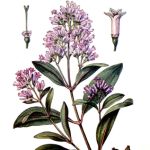| Common Name: |
Quinine |
| Other Names: |
Cinchona, Jesuit's Bark, Red Cinchona, Peruvian bark |
| Botanical Name: |
Cinchona pubescens |
| Genus: |
Cinchona |
| Family: |
Rubiaceae |
| Location: |
Equador |
| Cultivation: |
Well-drained, moist soil, with high humidity, in sun or partial shade. Commercial plantations are usually coppiced (cut back nearly to the ground) when about 6 years old. In late winter cut back specimen plants hard to encourage strong new growth. |
| Propagation: |
By nodal greenwood cuttings in late spring; by semi-ripe cuttings in summer at 15-18°C (59-64°F) |
| Harvest: |
Bark is collected from May until September, and dried for liquid extracts, tablets, or tinctures, or powder. It may be shaved off in situ or peeled from coppiced branches. |
| Height: |
25m (80ft) |
| Width: |
Variable |
| Warning: |
This herb, especially in the form of quinine, is subject to legal restrictions in some countries. |
| Hardiness: |
Min 15-18°C (59-64°F) |
| Parts Used: |
Stem and root bark |
| Properties: |
A bitter, astringent herb that lowers fever, relaxes spasms, and is anti-malaria (quinine), and slows the heart (quinidine). |
| Medicinal Uses: |
Internally for malaria, acute fevers, neuralgia, muscle cramps, cardiac fillibration; and ingredient of most proprietary cold and influenza remedies. Excess causes cinchonism; headache, rash, abdominal pain, deafness and blindness. Not given to pregnant women unless suffering from malaria. Externally as a gargle for sore throat. Used in homeopathy (as China officinalis) for nervous exhaustion, anemia, and convalescence.
To treat digestive problems, malaria, muscle pain, fever, flu, flatulence, and enlarged spleen. Germany's Commission E has approved the use of quinine to treat loss of appetite and dyspeptic complaints, such as heartburn and bloating. |
| Typical Dose: |
A typical daily dose of quinine in the form of cinchona liquid extract may range from 0.6 to 3.0 gm. |
| Possible Side Effects: |
Quinine's side effects include itching and eczema. |
| Drug Interactions: |
| Taking quinine with these drugs may increase the risk of bleeding and bruising: |
| Abciximab, (ReoPro) |
Antithrombin III, (Thrombate III) |
Argatroban, (Argatroban) |
Aspirin, (Bufferin, Ecotrin) |
| Aspirin and Dipyridamole, (Aggrenox) |
Bivalirudin, (Angiomax) |
Clopidogrel, (Plavix) |
Dalteparin, (Fragmin) |
| Danaparoid, (Orgaran) |
Dipyridamole, (Novo-Dipiradol, Persantine) |
Enoxaparin, (Lovenox) |
Eptifibatide, (Integrillin) |
| Fondaparinux, (Arixtra) |
Heparin, (Hepalean, Hep-Lock) |
Indobufen, (Ibustrin) |
Lepirudin, (Refludan) |
| Ticlopidine, (Alti-Ticlopidine, Ticlid) |
Tinzaparin, (Innohep) |
Tirofiban, (Aggrastat) |
Warfarin, (Coumadin, Jantoven) |
| Taking quinine with these drugs may be harmful: |
| Carbamazepine, (Carbatrol, Tegretol)—may increase blood levels of the drug. |
Quinidine, (Novo-Quinidin, Quinaglute Dura-Tabs)—may increase the therapeutic and/or adverse effects of the drug. |
|
| Disease Effects: |
May worsen gastrointestinal disorders by increasing the risk of bleeding. |
| Supplement Interactions: |
Increased risk of bleeding when used with herbs and supplements that might affect platelet aggregation. |
| Culinary Uses: |
Quinine is used as a bitter flavoring in tonic water, soft drinks, and alcoholic drinks, such as Campari and Dubonnet. |
| Bibliography: |
Encylopedia of Herbs by Deni Brown Copyright ©: 1995, 2001 Dorling Kindersley Limited pg 169
The Essential Herb-Drug-Vitamin Interaction Guide by Geo. T. Grossberg,MD and Barry Fox,PhD Copyright©2007 Barry Fox, PhD. Pp.384-385 |

